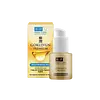What's inside
What's inside
 Key Ingredients
Key Ingredients

 Benefits
Benefits

 Concerns
Concerns

 Ingredients Side-by-side
Ingredients Side-by-side

1,2-Butanediol
HumectantPEG/PPG/Polybutylene Glycol-8/5/3 Glycerin
HumectantBetaine
HumectantSodium Hyaluronate
HumectantEthylhexylglycerin
Skin ConditioningHydrolyzed Sodium Hyaluronate
Skin ConditioningSodium Acetylated Hyaluronate
HumectantSodium Hyaluronate Crosspolymer
HumectantPEG/PPG-17/6 Copolymer
SolventGlycerin
HumectantGlyceryl Glucoside
HumectantCreatine
Skin ConditioningPanthenol
Skin ConditioningAcrylates/C10-30 Alkyl Acrylate Crosspolymer
Emulsion StabilisingPropylene Glycol
HumectantPalmitoyl Tetrapeptide-7
Skin ConditioningPalmitoyl Pentapeptide-4
Skin ConditioningPalmitoyl Tripeptide-1
Skin ConditioningCarnosine
Skin ConditioningCetyl-Pg Hydroxyethyl Palmitamide
Skin ConditioningCeramide EOP
Skin ConditioningCeramide Ns
Skin ConditioningCeramide NP
Skin ConditioningCeramide As
Skin ConditioningCeramide AP
Skin ConditioningMaris Aqua
HumectantLaminaria Digitata Extract
Skin ProtectingAvena Sativa Kernel Extract
AbrasiveHydrogenated Lecithin
EmulsifyingTocopherol
AntioxidantAllantoin
Skin ConditioningGlyceryl Acrylate/Acrylic Acid Copolymer
HumectantPvm/Ma Copolymer
Emulsion StabilisingSodium PCA
HumectantGlycine
BufferingCholesterol
Emollient1,2-Butanediol, PEG/PPG/Polybutylene Glycol-8/5/3 Glycerin, Betaine, Sodium Hyaluronate, Ethylhexylglycerin, Hydrolyzed Sodium Hyaluronate, Sodium Acetylated Hyaluronate, Sodium Hyaluronate Crosspolymer, PEG/PPG-17/6 Copolymer, Glycerin, Glyceryl Glucoside, Creatine, Panthenol, Acrylates/C10-30 Alkyl Acrylate Crosspolymer, Propylene Glycol, Palmitoyl Tetrapeptide-7, Palmitoyl Pentapeptide-4, Palmitoyl Tripeptide-1, Carnosine, Cetyl-Pg Hydroxyethyl Palmitamide, Ceramide EOP, Ceramide Ns, Ceramide NP, Ceramide As, Ceramide AP, Maris Aqua, Laminaria Digitata Extract, Avena Sativa Kernel Extract, Hydrogenated Lecithin, Tocopherol, Allantoin, Glyceryl Acrylate/Acrylic Acid Copolymer, Pvm/Ma Copolymer, Sodium PCA, Glycine, Cholesterol
Water
Skin ConditioningButylene Glycol
HumectantGlycerin
HumectantPPG-10 Methyl Glucose Ether
Skin ConditioningHydroxyethyl Urea
HumectantDiglycerin
HumectantPEG-32
HumectantTriethyl Citrate
MaskingGlycosyl Trehalose
Emulsion StabilisingUrea
BufferingSorbitol
HumectantCarbomer
Emulsion StabilisingPEG-75
HumectantDiethoxyethyl Succinate
SolventPhenoxyethanol
PreservativeDisodium Succinate
MaskingSodium Hyaluronate
HumectantPotassium Hydroxide
BufferingPolyquaternium-51
Skin ConditioningHexylglycerin
HumectantDisodium EDTA
Succinic Acid
BufferingHydrolyzed Hyaluronic Acid
HumectantSodium Acetylated Hyaluronate
HumectantAmmonium Acrylates Copolymer
Hydroxypropyltrimonium Hyaluronate
Pentylene Glycol
Skin ConditioningSodium Hyaluronate Crosspolymer
HumectantMethylparaben
PreservativeWater, Butylene Glycol, Glycerin, PPG-10 Methyl Glucose Ether, Hydroxyethyl Urea, Diglycerin, PEG-32, Triethyl Citrate, Glycosyl Trehalose, Urea, Sorbitol, Carbomer, PEG-75, Diethoxyethyl Succinate, Phenoxyethanol, Disodium Succinate, Sodium Hyaluronate, Potassium Hydroxide, Polyquaternium-51, Hexylglycerin, Disodium EDTA, Succinic Acid, Hydrolyzed Hyaluronic Acid, Sodium Acetylated Hyaluronate, Ammonium Acrylates Copolymer, Hydroxypropyltrimonium Hyaluronate, Pentylene Glycol, Sodium Hyaluronate Crosspolymer, Methylparaben
 Reviews
Reviews

Ingredients Explained
These ingredients are found in both products.
Ingredients higher up in an ingredient list are typically present in a larger amount.
Glycerin is already naturally found in your skin. It helps moisturize and protect your skin.
A study from 2016 found glycerin to be more effective as a humectant than AHAs and hyaluronic acid.
As a humectant, it helps the skin stay hydrated by pulling moisture to your skin. The low molecular weight of glycerin allows it to pull moisture into the deeper layers of your skin.
Hydrated skin improves your skin barrier; Your skin barrier helps protect against irritants and bacteria.
Glycerin has also been found to have antimicrobial and antiviral properties. Due to these properties, glycerin is often used in wound and burn treatments.
In cosmetics, glycerin is usually derived from plants such as soybean or palm. However, it can also be sourced from animals, such as tallow or animal fat.
This ingredient is organic, colorless, odorless, and non-toxic.
Glycerin is the name for this ingredient in American English. British English uses Glycerol/Glycerine.
Learn more about GlycerinSodium Acetylated Hyaluronate is a type of Hyaluronic Acid.
Hyaluronic Acids help moisturize, soothe, and protect the skin.
Read about common types of Hyaluronic Acid here:
Sodium Hyaluronate
Hydrolyzed Hyaluronic Acid
Hyaluronic Acid
Sodium Hyaluronate is hyaluronic acid's salt form. It is commonly derived from the sodium salt of hyaluronic acid.
Like hyaluronic acid, it is great at holding water and acts as a humectant. This makes it a great skin hydrating ingredient.
Sodium Hyaluronate is naturally occurring in our bodies and is mostly found in eye fluid and joints.
These are some other common types of Hyaluronic Acid:
Learn more about Sodium HyaluronateSodium Hyaluronate Crosspolymer is a type of hyaluronic acid. In fact, it is modified version of hyaluronic acid.
The structure of Sodium Hyaluronate Crosspolymer allows it to stay in the skin's top layer for a longer period of time. This allows for even more hydration and humectant action than hyaluronic acid.
These are some other common types of Hyaluronic Acid:
Learn more about Sodium Hyaluronate Crosspolymer